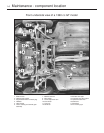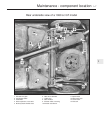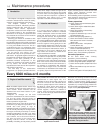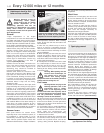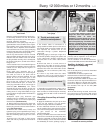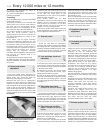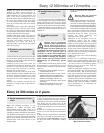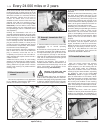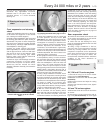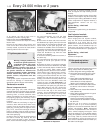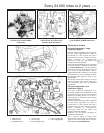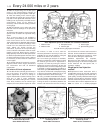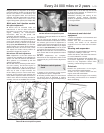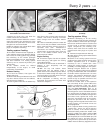
4 The oil level should reach the lower edge of
the filler/level hole. A certain amount of oil will
have gathered behind the filler/level plug, and
will trickle out when it is removed; this does
not necessarily indicate that the level is
correct. To ensure that a true level is
established, wait until the initial trickle has
stopped, then add oil as necessary until a
trickle of new oil can be seen emerging (see
illustration). The level will be correct when
the flow ceases; use only good-quality oil of
the specified type (refer to “Lubricants, fluids
and capacities”).
5 Filling the transmission with oil is an
extremely awkward operation; above all, allow
plenty of time for the oil level to settle properly
before checking it. If a large amount is added
to the transmission, and a large amount flows
out on checking the level, refit the filler/level
plug and take the vehicle on a short journey
so that the new oil is distributed fully around
the transmission components, then recheck
the level when it has settled again.
6 If the transmission has been overfilled so
that oil flows out as soon as the filler/level
plug is removed, check that the car is
completely level (front-to-rear and side-to-
side), and allow the surplus to drain off into a
suitable container.
7 When the level is correct, fit a new sealing
washer to the filler/level plug. Refit the plug,
tightening it to the specified torque wrench
setting. Wash off any spilt oil then refit the
access cover securing it in position with the
retaining clips.
22 Manual transmission oil
renewal
3
This service requirement is only applicable
to pre-1988 BE1 transmissions. Refer to the
procedures contained in Chapter 7A.
23 Automatic transmission fluid
renewal
2
1 Take the vehicle on a short run, to warm the
transmission up to normal operating
temperature.
2 Park the car on level ground, then switch off
the ignition and apply the handbrake firmly.
For improved access, jack up the front of the
car and support it securely on axle stands.
Note that, when refilling and checking the fluid
level, the car must be lowered to the ground,
and level, to ensure accuracy.
3 Remove the dipstick, then position a
suitable container under the transmission. The
transmission has two drain plugs: one on the
sump, and another on the bottom of the
differential housing (see illustration).
Warning: If the fluid is hot, take
precautions against scalding.
4 Unscrew both drain plugs, and allow the
fluid to drain completely into the container.
Clean the drain plugs, being especially careful
to wipe any metallic particles off the magnetic
insert. Discard the original sealing washers;
these should be renewed whenever they are
disturbed.
5 When the fluid has finished draining, clean
the drain plug threads and those of the
transmission casing. Fit a new sealing washer
to each drain plug, and refit the plugs to the
transmission, tightening each securely. If the
car was raised for the draining operation, now
lower it to the ground. Make sure that the car
is level (front-to-rear and side-to-side).
6 Refilling the transmission is an awkward
operation, adding the specified type of fluid to
the transmission a little at a time via the
dipstick tube. Use a funnel with a fine-mesh
gauze, to avoid spillage, and to ensure that no
foreign matter enters the transmission. Allow
plenty of time for the fluid level to settle
properly.
7 Once the level is up to the “MAX” mark on
the dipstick, refit the dipstick. Start the
engine, and allow it to idle for a few minutes.
Switch the engine off, then recheck the level,
topping-up if necessary. Take the car on a
short run to fully distribute the new fluid
around the transmission, then recheck the
fluid level as described in Section 5.
24 Driveshaft bellows check
1
With the vehicle raised and securely
supported on stands (see “Jacking and
vehicle support”), turn the steering onto full
lock, then slowly rotate the roadwheel.
Inspect the condition of the outer constant
velocity (CV) joint rubber bellows, squeezing
the bellows to open out the folds (see
illustration). Check for signs of cracking,
splits or deterioration of the rubber, which
may allow the grease to escape, and lead to
water and grit entry into the joint. Also check
the security and condition of the retaining
clips. Repeat these checks on the inner CV
joints. If any damage or deterioration is found,
the bellows should be renewed as described
in Chapter 8.
At the same time, check the general
condition of the CV joints themselves by first
holding the driveshaft and attempting to
rotate the wheel. Repeat this check by holding
1•14 Every 24 000 miles or 2 years
21.4 Topping-up the transmission oil level
23.3 Automatic transmission fluid drain plugs (arrowed). Transmission is refilled via the
dipstick tube (1)
24.1 Check the condition of the driveshaft
bellows (arrowed)



